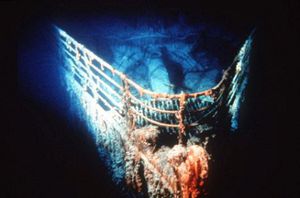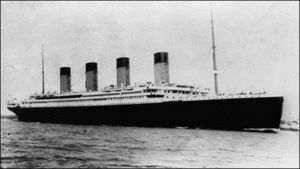Halomonas titanicae
A Microbial Biorealm page on the genus Halomonas titanicae
Classification
Higher order taxa
Domain: Bacteria
Phylum: Proteobacteria
Class: Gannaproteobacteria
Order: Oceanospirillales
Family: Halomandacae
Genus: Halomonas
Species: Halomonas titanicae [1]
Species
H. titanicae
|
NCBI: Taxonomy |
Description and significance
Halomonas titanicae is a gram-negative, bacilli shaped bacterium from strain BH1T. It's 0.5–0.8×1.5–6.0 μm in size It’s a motile microorganism which moves using flagella, and it has a peritrichous appearance. It is a psychrotolerant mesophile, it grows best between 30-37 degrees Celsius but is capable of growth at temperatures as low as 4 degrees Celsius [2]. This enables it to survive in the cold temperatures in its habitat at the bottom of the ocean. This bacterium collects on the side of metal surfaces, and was discovered on the ship the RMS Titanic. This bacterium was isolated from porous structures of corrosive by-product called rusticles. Rusticles also house 27 other species bacteria[2,3].
H. titanicae is significant because it is capable of accelerating the speed of which metals are corroded. Scientists are now gaining more information in regards to its destructive power. In 1995, scientists had thought the structure of the titanic would last 30 more years. However, with this bacterium’s destructive ability, it could be less than expected[3]. Although a tragedy to the Titanic, this new bacterium can be utilized to recycle the metal on other sea wrecks sitting idle on the ocean floor. By studying the structure and capabilities of H. titanicae new paints and coatings can be created that will aid in preserving ships and prevent against their degradation.
Due to its environment this bacterium is difficult to grow under laboratory conditions. Further research on it is difficult because it's challenging to reproduce colonies in a setting other than its natural habitat.

Genome structure
The genome size is 1453 base pairs (bp) and is linear [2]. Due to of the high variability of the 16S rRNA gene it was amplified and analyzed to classify the bacterium as a Halomonas (its closest relative being H. neptunia). The C+G content of the strain that this bacterium is from has been found to be 60.0 mol% [2]. This high C+G content enable the bacterium in being stable in the extreme environment it lives in.
Cell structure and metabolism
The Halomonas titanicae bacteria are gram-negative bacilli, as most species in the "Halomonas" genus are[4]. that are typically unpigmented or yellow tinted. It is an extreme halophile,salt loving, with peritrichous flagella for motility [2].
As a chemo-organotrophic organism its metabolism is respiratory. Catalase as well as oxidase are produced. They ferment D-galactose, D-glucose and D-fructose [2]. They are capable of anaerobic growth with the aid of glucose but in addition they are able to perform denitrification to gain energy through taking nitrate, but not nitrite, and converting it to nitrogen.
It is known as a "steel munching" bacteria because it metabolizes steel rust as with the Titanic. When the bacteria breaks down the rust it gains energy in the form of electrons from the degradation iron that is present.
Ecology

Halomonas titanicae inhabits a niche in the depths of the ocean where temperature is low and salt concentration is considerable. It belongs to the family Halomonadaceae, which generally inhabits environments that are salty [5]. H. Titanicae's optimal salt concentration is 2.0-8.0%, but can function between 0.5-25.0%. This bacterium clings to metal because that’s its main energy source. H. Titancae is valuable in decomposing metal, removing, recycling and returning iron back into the environment [6,7]. Although other species of bacteria are found in the rusticles with H.titanicae it is uncertain at this point if these organisms have a symbiotic relationship [6]. Research is still being conducted to determine of other species in the rusticles contribute to the degradation of the metal as well.
Pathology
Whiles some Halomonas strains have been shown to infect humans, currently there is no known evidence that H. titanicae has any pathological links in infecting humans or plants. It is, however, hazardous to metals, specifically those which contain high levels of rust due to its ability to deteriorate these man made structures [2,3,6]. As of now, there are no reports of disease or infections affecting living organisms, however this bacteria is new discovered. The researchers who made the discovery of the bacterium state that it is unknown of the bacterium was presents on the ship prior to its sinking in 1912 [6]. The only host of this bacteria is currently known to be the ship wreck of the Titanic.
Current Research
Enter summaries of the most recent research here--at least three required
Further research is currently being performed on the "Halomonas" genus and new bacteria are being discovered daily. As an extremophile group, "Halomonas" bacterium can grow under extreme conditions, high salt concentration, which could become significant in future biotechnological applications and mechanisms [4].
In 2010 Sanchez-Porro, et. al, were able to isolate H. titanicae and identify it as a new species. In their article these researchers give information regarding the bacterium's cell structure, size, metabolism, genome, and the niche it inhibits. Whether the bacteria was present on the ship prior to it sinking is unclear.
In the south Pacific regional ocean there is approximately 3,800 sunken war vessel including battle ships, tankers, oilers and air craft carriers. The fluids, oil, and explosives found on these vessels pose a threat to the environment. As these vessels decay harmful chemicals are released into the marine environment. Having detrimental effects on the wild life and fishing economy[8] Although this article didn't directly reference "H. titanicae", further research can be conducted to determine if this bacterium can be an adequate bio-remediation agent.
Further research is encouraged in the scientific community based upon the capabilities of current systems in relation to Halomonas titanicae. If there were some way to prevent H. titanicae growth on certain objects on the ocean floor, and subsequent decomposition of these objects, then structures such as oil rigs and other ocean deep engineering projects could have a much longer life span.
Cool Factor
The environment which the H. titanicae lives is very interesting. The idea that there is a living organism promoting rust at extremely low temperatures seems hard to believe since these living conditions are harsh.
Additionally it is really interesting that something as small as a Halomonas titanicae bacterium could basically destroy something so grand and historically momentus as the Titanic. Scientists indicate that in just a few more decades the wreck of the RMS Titanic will be no more. In some ways that's a little sad because the world is losing a part of its history, but in other ways it is kind of cool that the Earth has developed a way of recycling itself to this extent, obtaining energy from the most unlikely places.

References
Edited by student of Iris Keren 50. p. 489-500.]
1. "Halomonas titanicae." from http://www.ncbi.nlm.nih.gov/Taxonomy/Browser/wwwtax.cgi?id=664683.
2. Sanchez-Porro, C., Kaur, B., Mann, H., Ventosa, A. (2010). "Halomonas titanicae sp. nov., a halophilic bacterium isolated from the RMS titanic." International Journal of Systematic and Evolutionary microbiology 60(12): 2768-2774.
3. (2010). "Halomonas titanicae, a new form of bacteria." from http://coolscience.com.au/halomonas-titanicae.php.
4. Mata, J. A., Martinez-Canovas, J., Quesada, E., Bejar, V. (2002). "A detailed Phenotypic Characterisation of the Type Strains of Halomonas Species." Systematic and Applied Microbiology
5. Liu, W., Wang, J., Yuan, M. (2010). "Halomonas aidingensis sp. nov., a moderately halophilic bacterium isolated from Aiding salt lake in Xinjiang, China." Springer 99(3).
6. (2010). "New rust-eating bacyeria 'destorying wreck of the Titianic'." from http://www.dailymail.co.uk/sciencetech/article-1336542/Halomonas-titanicae-New-rust-eating-bacteria-destroying-wreck-Titanic.html.
7.(2010). "New Species of Rust-Eating Bacteria Destroying the Titanic." from http://www.livescience.com/9079-species-rust-eating-bacteria-destroying-titanic.html.
8.Monfils, R., Gilbert, T., Nawadra, S. (2006). "Sunken WWII shipwrecks of the Pacific and East Asia: The need ofr regional collaboration to address the potential marine pollution threat." Ocean & Coastal Magagment 49(9-10): 779-778.
